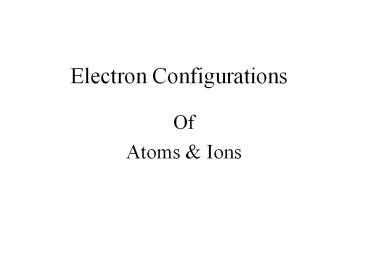Electron Configurations - PowerPoint PPT Presentation
1 / 11
Title:
Electron Configurations
Description:
Electron Configurations Of Atoms & Ions Men & their Rules Aufbau Principle: Start at the beginning (Electrons enter lowest energy level 1st) Pauli Exclusion Principle ... – PowerPoint PPT presentation
Number of Views:112
Avg rating:3.0/5.0
Title: Electron Configurations
1
Electron Configurations
- Of
- Atoms Ions
2
Men their Rules
- Aufbau Principle Start at the beginning
(Electrons enter lowest energy level 1st) - Pauli Exclusion Principle Only 2 allowed
- (Only 2 electrons allowed in any orbital)
- Hunds Rule Stay solo as long as possible
- (For orbitals of equal energy, 1 electron
enters each until all orbitals contain one before
any pairs up.)
3
Consequences of Aufbau Principle
- Electrons enter orbitals in order of increasing
energy levels. - This order is shown in text on page 111.
- 1s 2s 2p 3s 3p 4s 3d 4p 5s 4d 5p 6s 4f 5d 6p
- 7s 5f 6d 7p
- But there are two exceptions, namely Cu Cr, who
subtract 1 from 4s and add it to 3d.
4
Consequences of Pauli exclusion
- The s orbital is filled with 2 electrons.
- The 3 different orientations of the p orbital,
px, py, pz, each contain a max of 2 electrons - The 5 different orientations of d orbitals, dxy
- dxz, dyz, dx2-y2, dz2, can have max of 2
each. - The 7 different orientations of f orbitals also
only have 2 electrons for each suborbital.
5
Consequences of Hunds Rule
- One electron is added to px, then 1 to py, then 1
to pz, before the second one is added to px. The
5th electron is then added to py, 6th to pz. - The same pattern is observed for the d f
suborbitals. - NOTE The single electrons all have parallel
spins. When the 2nd electron is added to each
suborbital, it spins in the opposite direction.
6
Relating this to the periodic table
- The s block Groups IA IIA
- The p block Groups IIIB VIII (13-18)
- The d block Transition elements (Groups
IIIA-IIB Groups 3-12) - The f block Rare earth metals
7
What this means
- You merely need to follow the periodic table to
figure out electron configurations. - The block (s, p, d, f) indicates where the last
electrons go. - Follow the period numbers, 1-7, because these are
your energy levels then remember suborbitals
penetrate differently. - d block starts at 3d f block starts at 4f
8
How can we apply this?
- Follow the periodic table numerically
- 1s2 (takes you to He) 2s2 (to Be) 2p6 (to Ne) 3s2
(to Mg) 3p6 (to Ar) 4s2(to Ca) 3d1-3 (to V) - Cr (1st exception) 1s22s22p63s23p64s13d5
- Cu (2nd exception) 1s22s22p63s23p64s13d10
- Mn 1s22s22p63s23p64s23d5
- Zn 1s22s22p63s23p64s23d10
- Ga 1s22s22p63s23p64s23d104px1
9
Applications, continued
- La is beginning of the lanthanide series
- 1s22s22p63s23p64s23d104p65s24d105p66s25d1
- The pattern slightly changes with Ce
- 1s22s22p63s23p64s23d104p65s24d105p66s25d14f 1
- Pr puts it back on track
- 1s22s22p63s23p64s23d104p65s24d105p66s24f 3
- This is because 4f and 5d are close in energies
10
Noble Gas Configurations
- Instead of writing entire core electron
configuration of the noble gas, one can
abbreviate it NG write only valence e- - Al 1s22s22p63s23px1 or Ne3s23px1
- Ag1s22s22p63s23p64s23d104p65s24d9 or Kr5s24d9
- Am1s22s22p63s23p64s23d104p65s24d105p66s24f 14
5d106p67s25f 7 or Rn 7s25f 7 - Sg Rn7s25f 146d4 862144 106 Sb atomic
11
Orbital Notations
- This shows all 4 quantum numbers
- n (principle quantum ) energy lvl 1,2,3...
- l (angular momentum Q.N.) shape s,p,d,f
- m (magnetic Q.N.) x, y, z for p, etc
- s (spin Q.N.) 1/2 (cw) or -1/2 (ccw) shown
as upward or downward arrows - 16 8O ___ ___ ___ ___
___ - 1s 2s 2px y z































